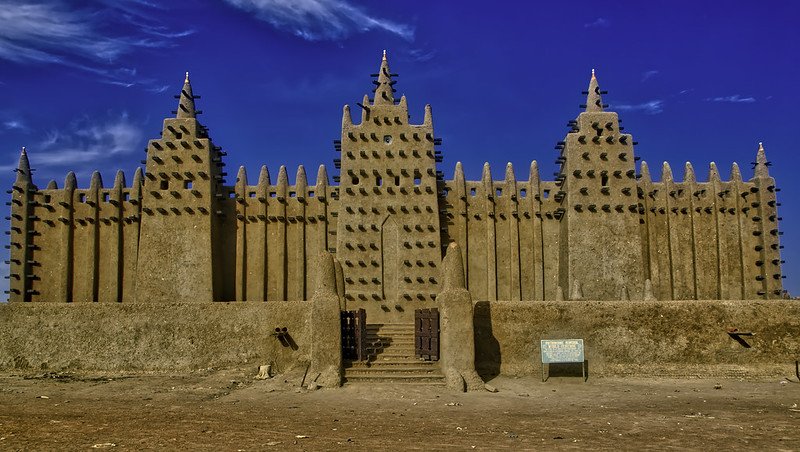
Each year the residents of a modest town in central Mali work together to preserve one of the most iconic structures in both Islamic and African architectural history: the Great Mosque of Djenne, the world’s largest mud-brick structure.
The community of Djenne, home to approximately 40,000 residents, sits near the Ban River. That river allowed the grand mosque to be built from a resource that is both local and sustainable: calcite-rich mud.

The minarets of the mosque are 52 feet high and sit atop a 300-foot long platform, perhaps a nod to seasonal flooding. The projected timber beams have been described as decorative and defensive by both sources, but they’re most readily understood as scaffolding.
The enchanting mosque and its unusual constructive practice continue to draw research and preservation efforts. The most recent of the latter is the mosque’s prominent role in discussions of Mali.
“The trapezoidal floor plan, protruding minarets, and forest of pillars inside the vast and naturally ventilated prayer hall are some of the many aspects … that make the Great Mosque of Djenne so remarkable,” reads the passage devoted to the mosque in the monumental “Sub-Saharan Africa Architectural Guide” a recently released monumental work on African buildings that was six years in the making.
The conical pillars atop the structure are each topped with ostrich eggs often described as symbols of fertility and good luck in Malian culture. However, Ostrich eggs were once common in mosques and churches across the Mediterranean — today, some can be found displayed inside the famed Blue Mosque in Istanbul, where they supposedly keep away spiders.
The bricks of the Djenne mosque are formed from banco, a term for the mixture of clay, water, shea butter, baobab tree powder and rice husks that form this mud. Before the start of the rainy season, the structures are usually replastered with mud. This replastering becomes a community event, with large numbers of residents contributing to the “Crepissage de la Grand Mosquée” (Plastering of the Great Mosque in French).
Music is played, and West African storytellers called “griots” traditionally entertain workers. These days different teams from various neighborhoods compete to finish their assigned task first with the winner taking home 50,000 West African francs, which equates to roughly $83 U.S. dollars. Construction lasts until dusk, but the music and festive atmosphere can last well into the night.
During the annual reconstruction, music and griot stories are often told for the enjoyment of the community workers. While construction stops at dusk, the music will often last long into the night, marking this mosque as both important site of both religious and cultural transmission.
The building is a masterpiece of the Sahelian Sudanese architectural style and continues to influence buildings in the so-called neo-Sudanese style today. An original mosque was built at the site between 1200 and 1350. The city’s heyday during the 15th and 16th centuries saw it blossom from an important trading hub to an important center of Islamic scholarship. The great mosque was known for hosting communal Friday (or Jummah) prayers for much of the city’s population during this period has expanded gradually over the centuries. For many, the mosque is known even today simply as the Jummah mosque.
Djenne was captured in 1810 by Fulani leader Sheikh Amadu, who accused the people of the town of committing profane activities inside the mosque. The original mosque was allowed to fall into disrepair, and a large one in a similar style was built just slightly to the east of the original site. This second mosque was constructed in the mid-1830s. A French journalist, Felix Dubois, who saw this mosque in 1895, described it as “simple, nue, banale.”
However, he was very much impressed by the ancient ruin. Indeed, according to the UNESCO World Heritage Designation of the site, the old city of Djenne and the mosque were influenced by Moroccan architecture and later marked by the Toucouleur Empire, which controlled the city in the late 19th century.
The large mosque was in ruins when the area was captured by French colonial troops in 1893.
Yet, the mosque soon captured French colonial imagination as well. In some ways, it was a wonder just as important to the French Empire as the Taj Mahal was to the British. In 1907, the French oversaw a reconstruction of the mosque under Ismaila Traoré, head of Djenné’s guild of mason.
Though broadly following the original mosque, some innovations were likely added — such as the arrangement of the three large towers of the qibla wall, which faces toward Mecca into a symmetric arrangement, and potentially the arrangement of pillars inside the prayer hall as well.

The mosque continued to feature in colonial photographs, and a cement version was built for use by Muslim tirailleurs serving in France after World War I, with artificial termite mounds nearby to complete the ambiance. This smaller cement replica was meant to serve as a cultural center for African troops serving in France. Following the independence of Mali in 1960, the original mosque became a major tourist attraction and one of Africa’s most famous structures.
Like the Taj Mahal, the mosque was often portrayed as a singular achievement rather than part of a larger cultural and architectural continuum. Similar Sudanese-style buildings can be found across the region from the Grand Mosque of Bobo-Dioulassso in Burkina Faso or the Larabanga Mosque, Ghana — the latter of which notably draws on the Djenne Mosque.
“The mosque isn’t a one-off structure in the north of Ghana; you can find similar — its one of many in the region,” said Sheikh Kishk Bashir Yandu, a Ghanian Imam who has traveled and studied across the region. “But it is reflective of the deep ties this style and indeed Islam has across West Africa.”
Produced in association with Religion Unplugged.







